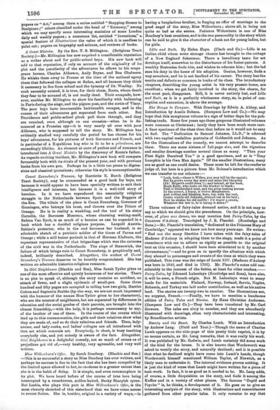Three volumes of fairy-tides demand notice, and it is not
easy to say to which we should give the precedence. On the principle, how- ever, of place aux dames, we may mention first Fairy•Talea, by the Countess d'Anlnoy. Translated by JAL Bench& (Rontledge and Sons.)—Mr. Planch6's translation, "dedicated to the Princess Mary of Cambridge," appeared we know not how many years ago. He writes: " Had out the many liberties I have taken with the fairy-tales of Madame d'Aolooy in adapting them to the stage, made it a point of conscience with me to adhere as rigidly as possible to the original text on this occasion, I should have been stimulated to it by another circumstance,"—and be goes on to specify the allusions with which they abound to personages and events of the time at which they were published. This time was the reign of Louis XIV. (Madame d'Anlnoy was born in 1649, and died in 1705). Mr. Planchd's notes add con- siderably to the interest of the fables, at least for older readers.— Fairy-Tales, by Edouard Laboulaye (Boutledge and Sons), have also, it will be seen, a French origin. But M. Laboulayo went to many lands for his materials. Finland, Norway, Iceland, Sends, Naples, Bohemia, and Turkey are laid under contribution, as well as his native land. The stories are twenty.two in number. The illustrations are, we anppoae, French.—Finally, we have to mention a handsome edition of Fairy Tales and Stories. By Hans Christian Andersen. (Sampson Low and Co )—They have been translated by Mr. Carl Blowers. The tales are sixty in number, and they are abundantly illustrated with drawings, often very characteristic and interesting, by Scandinavian artists.























































 Previous page
Previous page